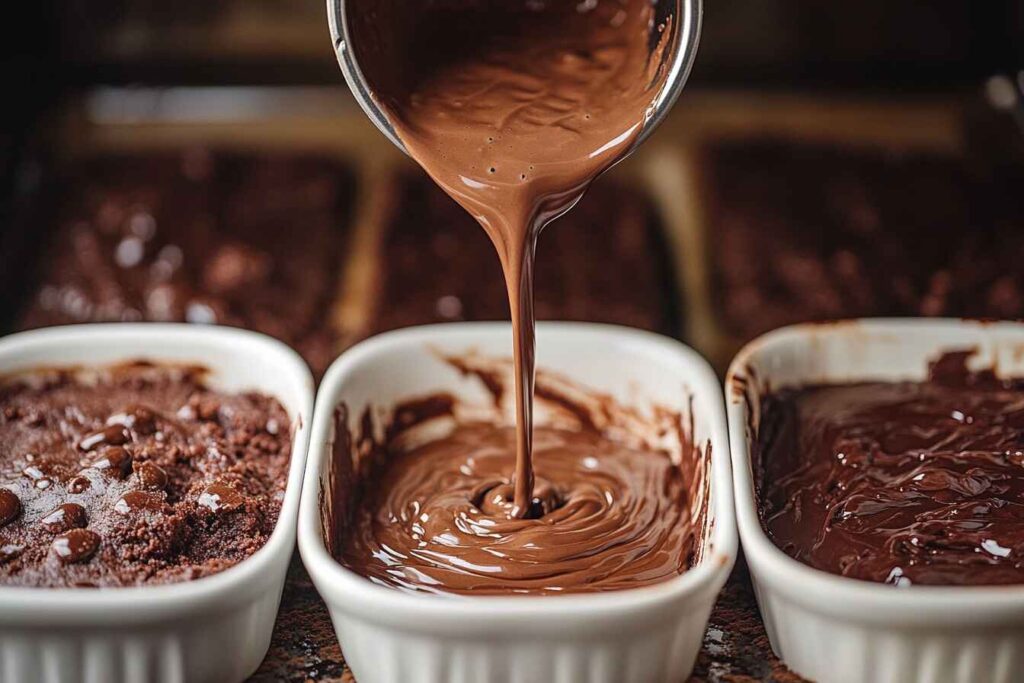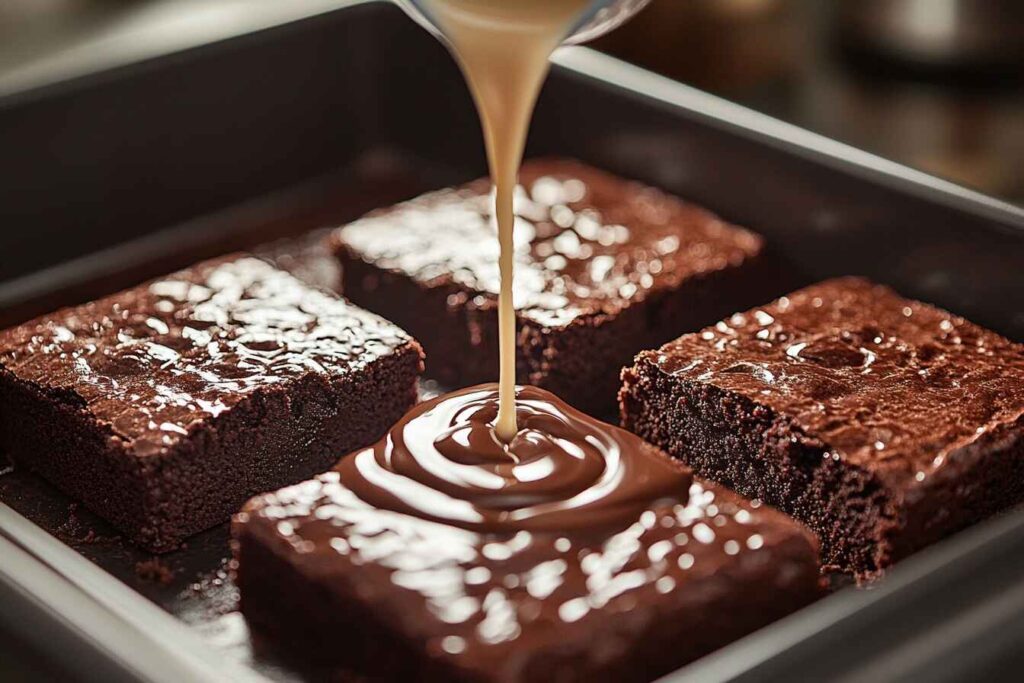Ever grabbed a box of brownie mix and wondered, “Can I use milk in box brownies instead of water?” You’re not alone! Many home bakers ask this same question while hoping to create richer, fudgier brownies. The good news? You can absolutely use milk in place of water, and it might just be the upgrade your brownies need.
In this guide, we’ll answer the burning question: Can I use milk in box brownies instead of water? We’ll also explore how milk affects the texture, flavor, and baking process. Whether you’re using whole milk, almond milk, or something else, there are tips and tricks you need to know to make your brownies bakery-quality.
So, can you use milk in box brownies instead of water? Let’s dive in and uncover why this swap could be your new baking secret.!
Why People Substitute Milk for Water in Box Brownies
Box brownie recipes typically call for water because it’s convenient and neutral. But here’s the thing—water adds moisture, not flavor. That’s where milk comes in.
- Milk contains fat and protein, which enhance the richness of brownies.
- It adds a slight creaminess, making the texture smoother.
- Milk-based brownies tend to have a mild caramelized taste due to the natural sugars in milk.
Fun Fact: Many professional bakers use dairy instead of water in recipes because the extra fat creates a softer crumb and a richer flavor.
But does milk affect how your brownies bake? Let’s dive into the science!
The Role of Liquid in Brownie Mix (Why It Matters)
Before you go swapping ingredients, it helps to understand why liquid is needed in the first place.
When you mix your brownie batter, liquid plays a key role in:
- Hydrating dry ingredients: Flour, cocoa, and sugar need moisture to combine properly.
- Activating the leavening agents: If your brownie mix includes baking powder or soda, liquid helps it rise.
- Creating the right consistency: The right amount of liquid ensures smooth, even baking.
Water does the job, but milk enhances these effects by adding fat, natural sugars, and proteins. This leads to more decadent brownies. However, there are a few things to consider before making the switch.
The Science Behind Using Milk Instead of Water
Milk doesn’t just add flavor—it changes the entire chemistry of your brownies.
How Milk Changes the Texture & Flavor of Brownies
Think about the difference between a basic sponge cake and a rich butter cake. The more dairy, the richer the result. The same goes for brownies.
- Water-based brownies tend to be more chewy and dense.
- Milk-based brownies have a softer, more moist and velvety texture.
“The fat in milk coats the flour particles, which limits gluten development. This means softer, more tender brownies.” — Chef Emily Carter, Pastry Expert
Does Milk Make Brownies More Moist and Fudgy?
Yes, but only if used correctly. Here’s the deal:
- Whole milk contains about 3.5% fat, which helps create a richer brownie.
- Lower-fat milk (like skim) has less impact on texture but still adds depth.
- Heavy cream makes brownies extra fudgy, but it may require adjustments in baking time.
If you love gooey, chocolatey brownies, switching to milk is a game-changer!
Will Milk Affect the Baking Time and Consistency?
Milk’s extra fat and protein slightly slow down the baking process. You may need to:
- Bake for an extra 2-3 minutes.
- Check for doneness by inserting a toothpick—it should come out with a few moist crumbs.
- Use a lower oven temperature (325°F instead of 350°F) for even baking.
Now that we know why milk works, let’s talk about the best type of milk to use.
Types of Milk You Can Use in Box Brownies
Whole Milk vs. Skim Milk: Which One Works Best?
If you’re swapping water for milk, whole milk is the best choice. It adds just the right amount of fat for a luscious brownie.
But what if you only have skim milk? It still works, but expect:
- A lighter texture (less dense than whole milk brownies).
- A slightly less rich flavor.
It’s still an upgrade from water, but if you want that bakery-quality taste, stick with whole milk.
Can You Use Almond, Oat, or Coconut Milk in Brownies?
Yes! If you prefer dairy-free options, these plant-based milks can work well:
| Milk Type | Effect on Brownies |
|---|---|
| Almond Milk | Mildly nutty, lighter texture |
| Oat Milk | Thicker, slightly sweet, soft texture |
| Coconut Milk | Richer, slightly coconutty, fudgier |
Tip: If using plant-based milk, go for unsweetened versions to control the brownie’s sweetness.
Heavy Cream vs. Evaporated Milk: Does It Make a Difference?
For an ultra-indulgent twist, heavy cream or evaporated milk can be used. Here’s how they compare:
- Heavy Cream: Super rich, adds a buttery taste, requires slightly longer baking.
- Evaporated Milk: Works well, but slightly reduces moisture.
If you love thick, chewy brownies, these dairy options are worth a try.

Common Problems When Using Milk in Brownies (And How to Fix Them)
So, you’ve swapped water for milk in your box brownie mix, but something seems off? Don’t worry! While milk can make brownies richer and more flavorful, it can also cause unexpected issues if not used correctly.
Below, we’ll tackle the most common problems and easy solutions to ensure your brownies turn out perfect every time.
Problem 1: Brownies Turn Out Too Dense – What Went Wrong?
Did your brownies come out too thick and heavy? Milk adds fat and protein, which can make the batter more compact.
Possible Causes:
- Too much milk – More liquid than needed can weigh down the batter.
- Overmixing – Too much stirring can develop gluten, making brownies denser.
- Not enough leavening – Some box mixes rely on baking powder or soda, which might need adjusting.
Solutions:
- Use the same amount of milk as water (no extra liquid).
- Mix just until combined—avoid overmixing!
- Consider adding ½ teaspoon baking powder for extra lift.
Problem 2: Why Are My Brownies Too Dry Even With Milk?
Surprised that your milk-based brownies came out dry? This happens when there’s not enough moisture retention in the batter.
Possible Causes:
- Baking too long – Milk causes a slower bake, so overbaking dries them out.
- Not enough fat – If you used skim milk, you might be missing key fats.
- Oven temperature too high – Box mixes are designed for water; milk needs a slight temp adjustment.
Solutions:
- Reduce baking time by 3-5 minutes.
- Use whole milk or add 1 tablespoon of melted butter for more moisture.
- Lower oven temp by 25°F (from 350°F to 325°F) for even baking.
Baker’s Tip: Brownies will continue to set as they cool, so take them out when they’re slightly underdone in the center!
Problem 3: How to Adjust the Baking Time When Using Milk
Milk adds fat and natural sugars, which slow down baking. If you don’t adjust the time, your brownies may end up undercooked or overbaked.
Solutions:
- Check brownies 3-5 minutes before the suggested time on the box.
- Use the toothpick test: A few moist crumbs = done.
- Let them cool completely before cutting (this helps set the structure).
Problem 4: Can Milk Make Brownies Too Sweet? (Balancing the Recipe)
Milk contains natural sugars (lactose), which can increase the sweetness of brownies. If your batch is too sweet, here’s how to fix it:
Solutions:
- Use unsweetened cocoa powder to balance out the sugar.
- Add a pinch of salt to cut through the sweetness.
- Use dark chocolate chips instead of milk chocolate for a richer flavor.
Best Tips for Using Milk in Box Brownies
Now that we’ve covered potential pitfalls, let’s answer the big question: “Can I use milk in box brownies instead of water?” Absolutely, and here’s how you can perfectly incorporate milk to achieve the best results. With just a few simple tweaks, your brownies will transform into a rich, decadent treat that’s impossible to resist.
Tip 1: Ideal Milk-to-Water Ratio for Perfect Brownies
Don’t just pour in a random amount of milk—stick to the correct ratio!
| Original Water Amount | Recommended Milk Substitute |
|---|---|
| ¼ cup water | ¼ cup whole milk |
| ⅓ cup water | ⅓ cup whole milk |
| ½ cup water | ½ cup whole milk (or ¼ cup milk + ¼ cup heavy cream for extra richness) |
Pro Tip: If you want extra fudgy brownies, replace half of the milk with heavy cream!
Tip 2: Mixing Techniques for a Smooth Brownie Batter
Avoid lumpy, uneven brownies by using the right mixing method.
Steps for the Perfect Brownie Batter:
- Whisk eggs, oil, and milk together before adding to the mix.
- Use a rubber spatula (not a whisk) to fold the ingredients gently.
- Stop mixing when the batter is just combined—a few streaks of flour are okay.
Tip 3: Pro Baker Secret—Combining Milk with Other Ingredients
Want to take your brownies to the next level? Try these secret upgrades:
- Add a teaspoon of espresso powder—Enhances the chocolate flavor.
- Use brown butter instead of oil—Adds a deep, nutty taste.
- Mix in ½ cup of sour cream—Boosts richness and moisture.
Bonus Hack: For a gooey center, bake at 325°F and let the brownies sit for 10 minutes before cutting.
Can You Use Other Dairy Substitutes? (Butter, Yogurt, and More)
If you’re out of milk, there are plenty of other dairy options to experiment with.
| Substitute | Effect on Brownies |
|---|---|
| Butter (melted) | Rich, buttery texture |
| Greek Yogurt | Slightly tangy, very moist |
| Buttermilk | Soft, slightly tangy, cakier texture |
| Heavy Cream | Fudgy, ultra-rich |
These swaps can be fun to try if you want to experiment with different textures and flavors!
Frequently Asked Questions About Using Milk in Brownies
Got questions? You’re not alone! Here are the most common queries bakers have when swapping water for milk in brownies:
Can I Use Any Type of Milk?
Yes, but the type of milk you use affects the texture and flavor. Whole milk is ideal for a creamy, moist finish, while skim milk may result in slightly less richness. Non-dairy options like almond or oat milk also work but might add subtle flavor changes.
What About Lactose-Free Milk?
Absolutely! Lactose-free milk behaves just like regular milk in recipes. You’ll get the same rich and moist brownies without upsetting sensitive stomachs.
Does Milk Change the Baking Time?
Yes, slightly. Milk adds fat and sugar, which can slow down baking. Check your brownies 3–5 minutes earlier than usual, and use the toothpick test for accuracy.
Can I Use Milk If I Want a Fudgier Texture?
Definitely! For extra fudginess, consider swapping half of the milk with heavy cream or even using evaporated milk for a denser, gooey center.
Debunking Myths About Milk in Brownies
There’s no shortage of baking myths, especially when it comes to ingredient swaps. Let’s set the record straight:
Myth 1: Milk Always Makes Brownies Too Sweet
False! While milk contains natural sugars, its sweetness is balanced by the rich fats it adds. If you’re concerned, a pinch of salt will keep things in check.
Myth 2: Non-Dairy Milks Don’t Work
Not true! Almond, soy, oat, or even coconut milk can all be used to create delicious brownies. Just be mindful of flavor differences—coconut milk, for example, will add a tropical twist.
Myth 3: You Can’t Use Milk in Gluten-Free Brownie Mixes
Wrong! Gluten-free mixes work just as well with milk. In fact, the added richness can improve the texture of gluten-free baked goods.
Myth 4: Milk Reduces Shelf Life
Another myth busted! Milk-based brownies last just as long as water-based ones if stored properly in an airtight container at room temperature or in the fridge.
Final Verdict: Should You Always Use Milk in Box Brownies?
So, is milk the ultimate brownie hack? Yes and no. It depends on your personal taste and the result you’re aiming for.
When You Should Use Milk:
- If you want richer, creamier brownies.
- When making fudgy-style brownies.
- For flavor enhancement and added moisture.
When to Skip Milk:
- If you prefer a lighter, cakier texture.
- When using a mix specifically designed for water (rare, but check the label).
- If you’re trying to cut calories or fat.
At the end of the day, it’s all about experimentation. Milk adds an element of creativity to your baking, letting you customize your brownies to fit your cravings.
Best Practices for Foolproof Milk-Based Brownies
Ready to nail your next batch of brownies? Follow these pro tips for consistent, mouthwatering results:
1. Measure Carefully
Exact measurements are key when swapping ingredients. Too much or too little milk can throw off the texture.
2. Mix Just Enough
Overmixing develops gluten, leading to dense brownies. Stir just until the batter comes together—no more, no less.
3. Keep an Eye on the Oven
Milk-based brownies can bake faster or slower depending on your oven. Use the toothpick test to ensure doneness without drying them out.
4. Cool Before Cutting
Patience pays off! Let your brownies cool completely to avoid crumbling or breaking when slicing.
5. Store Properly
To keep brownies fresh, store them in an airtight container at room temperature for up to three days or refrigerate for a week.
Pro Tip: Wrap individual brownies in plastic wrap before freezing for easy grab-and-go treats later.

Conclusion
Using milk in box brownies is a game-changer! Wondering, “Can I use milk in box brownies instead of water?” The answer is a resounding yes. This simple swap delivers richer flavors, smoother textures, and countless customization options. Whether you’re a baking pro or just starting out, using milk instead of water takes your brownies from good to truly irresistible.
So, what are you waiting for? Grab that brownie mix, ditch the water, pour in some milk, and bake your way to deliciousness. Your taste buds will thank you, and your brownies will never be the same!

